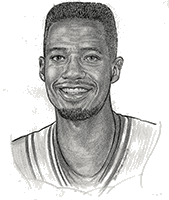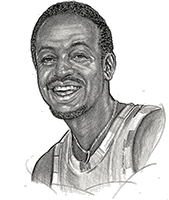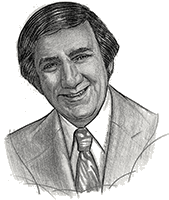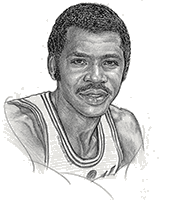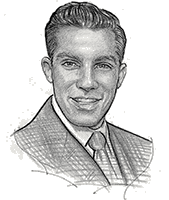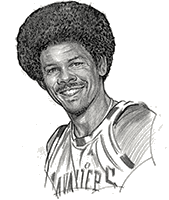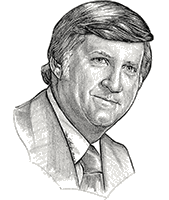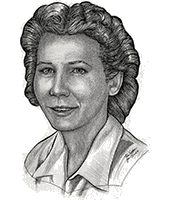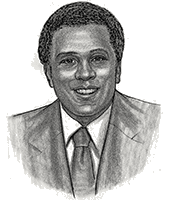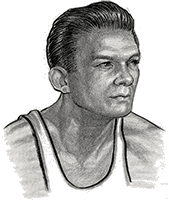Warrensville Heights already boasted an enviable record as a small school which produced outstanding athletes when one of its future students began his adolescent growth spurt in the mid-70s. By the time he reached high school age, he was nearly seven feet tall, and while he was a bit on the spindly side, it was evident that WHS was on the brink of welcoming its next quality sports star in the person of basketball prospect Brad Sellers. Hope became reality, and by the time he reached his senior season, major college scouts were beating a steady path to the doors of the Tigers gym. Wisconsin won the recruiting battle and Sellers enjoyed two good seasons in Madison, averaging 15.3 points and nine rebounds over 55 games in 1981-82 and 1982-83. His 838 points made him just the fourth UW player to top 700 by the end of his sophomore season. But, at the end of that second season, he elected to transfer to Ohio State, where he stepped it up a notch, averaging 17.8 points and a prodigious 10.8 rebounds over two years. His 416-rebound total in 1985-86 still ranks as the fourth best single season total in OSU history. Even more impressive, his 187 blocked shots rank as the Bucks’ third best CAREER total. The Chicago Bulls made him the 9th pick in Round One of the 1986 NBA draft and he went on to play the first three of his six NBA seasons with Chicago, then split three ensuing campaigns among Seattle, Minnesota and Detroit. Although his best season was the 1987-88 campaign with the Bulls when he started 76 games averaging 9.4 ppg, his most memorable moment may have come in the 1987 playoffs when he made the last second pass to Michael Jordan that Jordan converted into “The Shot” which eliminated Cleveland from the playoffs. Still living in Warrensville Heights, he is now the city’s community liaison director.
Honors went hand-in-large-hand with the consistently solid basketball play of one Michael “Campy” Russell during a spectacular college and professional career. The Pontiac (MI) Central High product played just two varsity seasons with the University of Michigan, averaging 18.4 points as a sophomore, then 23.7 points and 11.1 rebounds as a junior in 1973-74. His second-year totals were enough to enable him to lead the Big Ten in scoring, finish second in rebounding, earn unanimous acclaim as the Big Ten Player of the Year and All-American status, and sufficiently impress the Cleveland Cavaliers to take him with the 8th overall pick in the 1974 NBA draft. He more than lived up to his college reputation during a nine-year pro career which ended in 1984. Seven of those seasons were with the Cavs, reaching a zenith in 1978-79 with a career high scoring average of 21.9 ppg, a single game career high of 41 against Phoenix and a place on the NBA All-Star team. He averaged 15.0 ppg for the Cavs’ revered “Miracle of Richfield” team of 1975-76, which made the playoffs for the first time and advanced to the second round. He finished his playing days, which included two seasons (1980-82) with the New York Knicks, with a cumulative NBA scoring average of 15.8 ppg and a playoff scoring average of 16.6 ppg. From 1975-76 through the 1981-82 season, he averaged double figures in scoring every year. In 1999 he was voted to the Cavs’ all-time team and into the University of Michigan Hall of Honor in 2002. He lived in Michigan from shortly after retirement as an active player until 2002 when he accepted an offer to return to the Cavs as an Outer Market Event Specialist. A proud father of five, Campy currently makes his home in Shaker Heights.
On a quiet news day in 1968, unsuspecting Greater Clevelanders were mildly surprised to learn that a little-known local attorney had purchased the Cleveland Arena and its prime tenant, the Cleveland Barons of the American Hockey League. Little did they know they were reading the opening chapter of a local sports saga which in the next decade would see the construction of the largest sports empire in the city’s history, with surprises galore to come. The ink had barely dried on the Arena purchase papers when Nick Mileti set out to lure an NBA expansion team to his new building. In 1970 he was rewarded with a team he named the Cleveland Cavaliers and dressed in the Wine and Gold colors of his alma mater, John Adams High. Next, he turned his eyes to the Cleveland Indians, who were openly seeking greener fields. Teaming with a group of civic activists, he purchased the team on March 22, 1972 for $9 million. A month later, learning the Calgary Broncos of the newly-formed major league-conscious World Hockey Association would be shifted because of financial woes, he bought the franchise, shuffling the minor league Barons off to California. Now, with two indoor sport teams in his bulging major league stable, he turned his attention to replacing the aging Arena with a state-of-the-art big league home. Unable to work out an arrangement for a site in the City of Cleveland, he pulled off his climactic sports surprise by building the opulent 22,000-seat Coliseum midway between Cleveland and Akron on a site in Richfield literally surrounded by cornfields. He opened the building with a gala Frank Sinatra concert in 1974. The empire would slowly dissolve after that, but when he left Cleveland in 1979 for Beverly Hills to produce and finance plays and motion pictures, he left behind him Indians and Cavaliers teams whose presence would serve as the impetus for the construction of a new downtown sports complex forever altering the heart of downtown Cleveland.
In an era when 6-6 high school basketball centers were considered premium “big men” East High School’s 6-8 Emanuel “Manny” Leaks was both giant and giant-killer. By the end of his senior season in 1963-64, he had earned a prominent place for himself on an impressive list of East High stars. His fierce rebounding and steady scoring provided the twin engines which propelled the Blue Bombers all the way to the finals of the ’64 Ohio AA (large schools) championship game and himself to All-Scholastic, All-Ohio and Parade Magazine All-American honors. En route to the state title game, East recorded its third win of the season over East Tech in the regional championship game, ending a string of six straight Scarab appearances in the state finals. The Blue Bombers then obliterated Elyria 58-31 in the state semi-final game before losing to Dayton Belmont in the final. Continuing his career at Niagara University, where he would be teamed in his final season with future immortal Calvin Murphy, he carved out a large place for himself in the Purple Eagles’ record book. Thirty six years after his final season in 1967-68, Leaks still ranks second on the school’s career rebounding list with 1087, holds three of its top 10 season rebounding marks, three of its single game rebounding highs, and is 18th on the career scoring leaders’ list with 1,243 points, an average of 17.3 per game. He went on to play six pro seasons with four different ABA teams and a pair of NBA clubs. His finest effort came in 1969-70 when he averaged 18.8 ppg and 12.5 rebounds for the Dallas Chaparrals in the ABA. Now a real estate investor, he resides in Cleveland.
Even in the 1940s when 6′ 5″ high school basketball players were considered giants, Marlo Termini was still classified as a “mighty mite.” Thus it was understandable why the 5′ 2″ Holy Name High School junior guard captured the imagination of Cleveland sports fans when he led his team to its first-ever city cage championship with a 39-32 victory over Collinwood at Public Hall in 1944. The tiny co-captain was both the team’s brainy floor general and scoring leader at 11.4 ppg. and was named to the All-Senate team. He seemed to be on track for a spectacular senior season, but there was a war on, and he spent the 1945 season in the army instead. After his release, he enrolled at the University of Dayton and became an immensely popular player in the Flyers’ strong cage program before he left to join a Detroit semi-pro team. Later he turned his considerable talents to fast-pitch softball, at a time when Cleveland was a hotbed of the sport. He starred for several championship clubs and, as a center fielder and speedy lead-off hitter, earned a reputation as one of the best ever to play the game here. In a 14-year career he never played on a losing club and was a key player on the 1957 General Teamsters team that became the first squad to represent the city in the national championships in 30 years.
One of the original Cleveland Cavaliers, Bingo Smith was picked in the 1970 expansion draft from the San Diego Rockets, who had made him a first round choice in the previous year’s college draft. The ex-Tulsa University All-American became an instant hit in Cleveland with his patented rainbow jumper often fired from the farthest reaches of an arena. Then, on his historic night in April, 1976 at the Richfield Coliseum, one of those long distance bombs was to become one of the most famous shots in Cavaliers history: a last-second three-pointer that earned the team its first-ever post-season playoff game victory. Immediately, it was immortalized as “The Miracle of Richfield.” There were many other points scored by Smith as well: 9,513 in regular season games (fourth best total in Cleveland history) and 198 in post season play. In his nine-plus seasons with the Cavs, Bingo did more than enough to merit retiring his No.7 jersey and his recent selection as one of the team’s top 12 players of all time. Traded back to San Diego in the 1979-80 season, he retired after that campaign and returned to Cleveland where he has devoted much of his time to working with youth groups in the Northeastern Ohio area.
A devoted friend of handicapped and underprivileged youngsters and of sports and athletes on both amateur and the professional level, he owned the Cleveland Pipers basketball team, an early entry (1950s) in professional basketball here and headed Group 66, an organization devoted to promoting civic improvement, including the support of athletic programs, in Cleveland. Became principal owner of the New York Yankees in 1973.
A national AAU All-American center in 1943, Frances Kaszubski began her career in 1934 as a member of the Polish Falcons. Went on to play for Blepp-Coombs, No-Kolds and Fisher Foods in the Cleveland Muny Women’s Class A League. Was MVP of the Inter-city Tournament in 1936 and scored seven points in 59 seconds in an international series the next year when a center tipoff followed each goal.
Ken Glenn was one of the top stars of East Tech’s greatest teams, scoring 1,159 points in 76 games from 1957-1959. Named All-American, All-Ohio and MVP of the 1959 Ohio state tournament all-tournament team as East Tech captured the state title. In 1958 he earned all-scholastic, All-Ohio and all-state tournament team honors. Went on to star for Niagara University and continued to play amateur basketball until 1978.
Enjoyed an exceptional career at St. Ignatius High School, earning all-scholastic honors three straight years and All-Ohio laurels as a senior, when he captained the Cleveland News all-scholastic team. Scored a then-amazing 58 points in one game in 1951. Named All-European Theatre in basketball, baseball and football while serving in the U.S. Army from 1953-55. Went on to play for the University of Dayton and one season for the professional Cleveland Pipers.
2001 Crocker Rd., Ste. 510, Westlake, OH 44145
Phone: 216-241-1919

